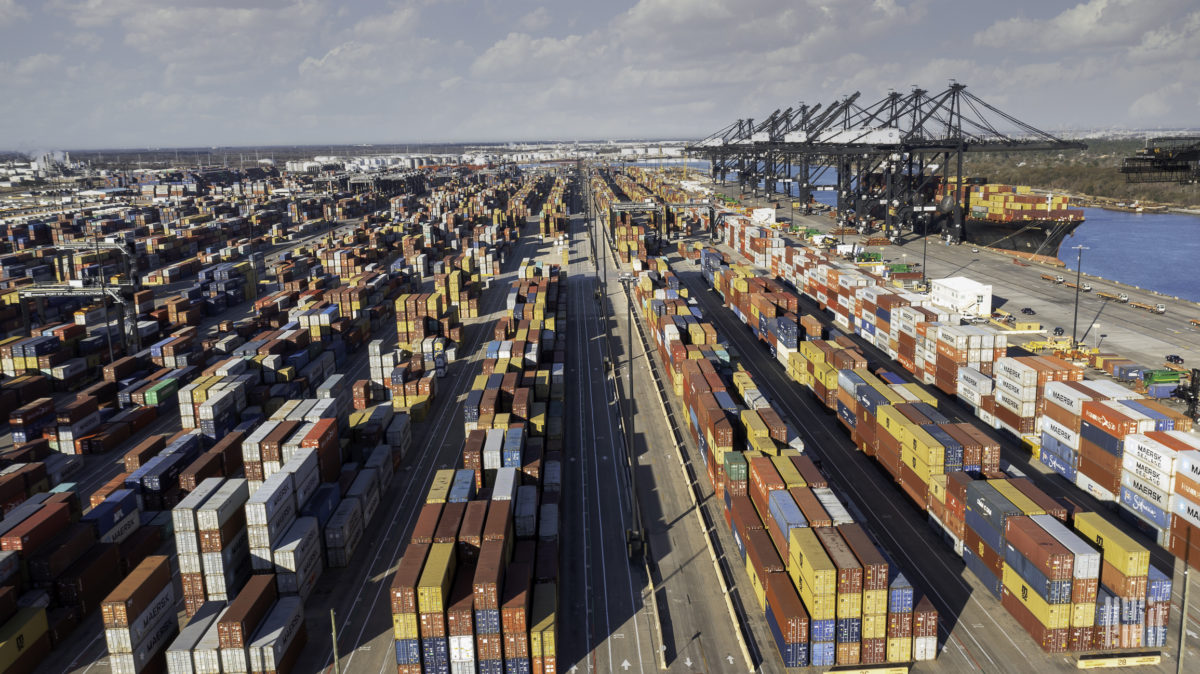Expanding a strategy aimed at clearing congested U.S. container ports by using more off-site space must take into account potential added costs related to trucking as well as other factors, according to feedback obtained by federal transportation officials.
The plan, coordinated and promoted last year by White House port envoy John Porcari, was included in the Ocean Shipping Reform Act of 2022 to assess how it could be rolled out on a larger scale.
The act, signed into law in June by President Joe Biden, required the U.S. Department of Transportation to convene a meeting with the U.S. Maritime Administration (MarAd) and the U.S. Federal Maritime Commission on the use of federal and other sites, including inland ports, for storing and transferring containers from overstressed seaports.
The Sept. 26 meeting was followed by a request for comments from the transportation industry to help assess an expansion of the concept.
“While no port wants to have containers idling for excessive periods, moving certain containers inland via rail, barge, or other means can reduce the number of containers waiting for drayage, and subsequently reduce truck and chassis congestion at the seaport itself,” said Chris Connor, American Association of Port Authorities (AAPA) president and CEO, in comments to DOT. “In that regard, inland ports are a helpful tool in the arsenal of methods ports can use to maintain fluidity.”
The South Carolina Ports Authority pointed out that it has operated two inland ports for over 13 years that have moved exports and imports to and from its southeastern U.S. seaports via intermodal rail, reducing over-the-road truck volumes.
However, while more traditional cargo and storage and transfer yards located closer to the port can improve supply chain fluidity, “they generally require second re-handles and inefficient routings to move the cargo,” SCPA told DOT. “Additional truck drivers, newer and more voluminous chassis fleets, enhanced logistic information exchange capabilities are also necessary, but unless they are provided in a cost competitive manner, they would not be prioritized over new space utilization.”
Responding to DOT’s question as to whether it would consider using additional storage and transfer space in the U.S. to mitigate congestion, Taiwan-based Yang Ming Marine Transport, which operates a fleet of 95 container ships, answered “yes” — but extra drayage costs and time required to move to off-port space should also be considered, the carrier stated.
“If the use of [an] inland port is comparably more costly and time-consuming than storing [at the port] terminal, and with the possible trucker shortage/supply issue still not resolved, it’ll be challenging or even difficult to support it long term,” Yang Ming cautioned.
The Port of Houston, where 97% of containerized cargo moves by truck, is particularly vulnerable to the shortfall in available drivers, according to Roger Guenther, the port’s executive director. “Adding additional miles and hours to their trips, along with increasing the demand for new drivers, must be weighed with the proposed benefits,” Guenther told DOT.
Even inland ports with direct rail connections can be vulnerable, according to Evergreen Shipping Agency (America) Corp., the intermodal agent for container ship operator Evergreen Line. It noted that the railroads are having their own congestion issues.
“A governmental review committee is suggested to meet with rail carriers in order to identify solutions to the current needs and future requirements,” the company commented. “Investment in assets is required, as enhancements to existing terminals and equipment, along with [investment in] new terminals…are necessary to avoid the bottlenecks of the last two years and/or future repetition.”
In terms of investment, DOT has started funneling money to ports that can use the funds to advance the strategy, at least for off-site container storage. DOT’s MarAd announced on Friday $36.6 million for Oakland, California’s, Outer Harbor Terminal Redevelopment Project, which includes a 25-acre off-dock container support facility announced earlier this year.
The funding is part of a $703 million tranche for 41 projects awarded through MarAd’s Port Infrastructure Development Program.
Asked by DOT what the government could do to help inland ports untangling supply chain bottlenecks, commenters responded that federal funding, such as the money included in last year’s infrastructure bill, is important.
“However, a barrier for many emerging ports to access these grant programs are the match requirements,” said John Charles Edwards, economic development director for Helena Harbor, an inland river port on the Mississippi River in Phillips County, Arkansas.
“Reducing the match requirements for developing ports will enable more ports to access the funding needed to make them competitive.”











Frank Hammond
Biden’s container plan? Joe actually knows what a container looks like? Great to see you are starting your Biden for ’24 campaigning early – you will be rewarded for your Democrat hack articles.
TODD Reeves
Be so glad when the adults are back in charge and not the 4th graders!!